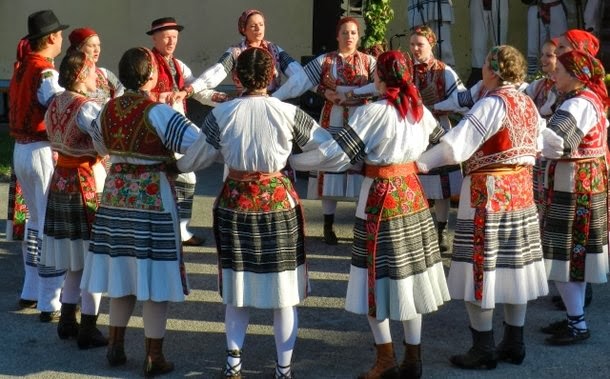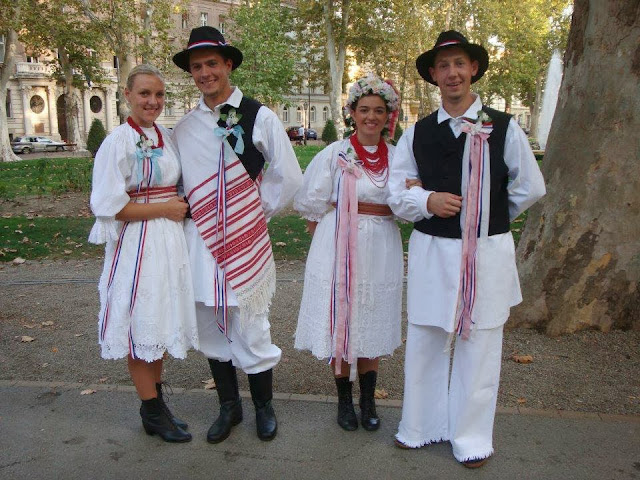Hello all,
Croatia is a rather small country, but has an amazing number and variety of Folk Costumes. The basic difference between Croatians, Serbs and Bosniaks is nominally religion. Croatians are Roman Catholic, Serbs are Byzantine Orthodox, and Bosniaks are Muslim. Other differences are strictly local. There is no correspondence between a map of the three nationalities with the political borders, the various dialects, the various types of costumes, cultural zones, etc. Today, of course, many people have a deep seated sense of nationality, so it has become a part of their personal identity.
The Pannonian zone is comprised of the lowland areas of eastern Croatia, as well as northern Bosnia and Vojvodina. The costumes of this zone bear far more resemblance to each other than they do to other parts of any of these three countries.
Compare these two photos, the first is of a Serbian man from Slavonia, the second of a Croatian man from Slavonia.
The two sashes each have the stripes ordered according to the appropriate national flag, but that is the only significant difference.
On a map of Croatia, the Pannonian zone makes up the eastern half of the country, from the narrow waist.
I will be referring to the costumes according to their traditional cultural areas, which do not match current political divisions; this map above shows their approximate locations. These areas are often bounded by geographical features.
I will cover the areas roughly from west to east.
This map will be of some help, although many of the villages mentioned are not shown. It may be helpful to open Google maps and look up the villages as they are mentioned.
I need to stress that while I will include many costumes, this presentation is NOT exhaustive.
1. POKUPLJE
This area is in the western part of pannonian Croatia and basically consists of the basin of the Kupa river, which rises in the Dinaric mountains and passes Karlovac on its way east to drain into the Sava river.
From west to east:
Western group:
Karlovac
Draganić
https://www.youtube.com/watch?v=QogQpvgBAR0
Rečica
Eastern group
Kupinec
Bratina
Costume parade in Bratina
https://www.youtube.com/watch?v=72tpiP9Cwa0
Jamnica
The pleats typical of this costume make the entire outfit come alive when doing the typical Croatian shake dances.
A commercial showing some dancing from Jamnica
https://www.youtube.com/watch?v=OzysdQL-x2Y
A medley of songs and dances from Pokuplje, showing three of the costumes
https://www.youtube.com/watch?v=lM8Ffv-3qGQ
2. PRIGORJE
This term means 'the land this side of the mountain'. The mountain referred to is the highland region just north of the city of Zagreb. This region consists of the foothills south of the mountains and includes the Zagreb area. Again, from west to east:
Jastrebarsko
Samobor
Local dance group from Samobor
https://www.youtube.com/watch?v=td4VmzAi2ws
Zagreb area
Sesvete

6. BILOGORA
This region consists of the highlands just south of the Drava river basin.
Local dance group from Bilogora
https://www.youtube.com/watch?v=v5h5SK4DLSk
https://www.youtube.com/watch?v=72tpiP9Cwa0
Jamnica
The pleats typical of this costume make the entire outfit come alive when doing the typical Croatian shake dances.
A commercial showing some dancing from Jamnica
https://www.youtube.com/watch?v=OzysdQL-x2Y
A medley of songs and dances from Pokuplje, showing three of the costumes
https://www.youtube.com/watch?v=lM8Ffv-3qGQ
2. PRIGORJE
This term means 'the land this side of the mountain'. The mountain referred to is the highland region just north of the city of Zagreb. This region consists of the foothills south of the mountains and includes the Zagreb area. Again, from west to east:
Jastrebarsko
Samobor
Local dance group from Samobor
https://www.youtube.com/watch?v=td4VmzAi2ws
Zagreb area
Sesvete
3. ZAGORJE
This term means 'the land beyond the mountain'. This region consists of the land from the highlands just north of Zagreb to the Slovenian border and the Drava river.
Again, roughly from west to east:
Kumrovec
This area is in the northwest corner of Zagorje.
Local dance group
Kupljenovo, Zaprešić and Bistra form a coherent costume region in the southwest corner of Zagorje. The differences between the costumes are small.
Bedjna is in north central Zagorje.
Jalžabet is in eastern Zagorje, not far from the ciy of Varaždin.
Songs and dances of Zagorje
https://www.youtube.com/watch?v=w8OFqIxRDOc
4. MEDJIMURJE
This region consists of the triangular part of Croatia which lies north of the Drava river and borders on both Slovenia [Prekmurje] and Hungary.

Songs and dances of Medjimurje
5. PODRAVINA
This region lies in the lowlands along the Drava river where it forms the Hungarian border as far east as the city of Virovitica.
A stage presentation of wedding traditions and dances of Podravina
This region consists of the highlands just south of the Drava river basin.
https://www.youtube.com/watch?v=v5h5SK4DLSk
7. Banovina or Banije
This area lies in the southwestern corner of this region, next to Kordun and Bosnia. In Luščani and nearby areas, a distinct costume has been retained. It resembles Bosnian costumes more than that of other parts of Croatia, and includes a back apron with long fringes that are more typical of Vlach costumes found much further east.
Here is a performing group doing dances from this region. Notice that the movements emphasize the fringes on the back apron. Some of the younger dances are wearing a newer style of costume more influenced by nearby Pannonian costumes.
Another group from this region. This one is less professional.
8. POSAVINA
The regions of Moslavina, Turopolje and parts of Banovina have been so influenced by the costume of Posavina that I will present them as one region. This is the most famous and the most spectacular costume of Croatia. Posavina consists of the Sava river basin, especially the area south of the city of Sisak. The other three regions lie east, north and west of Posavina, and while they have retained some particular regional costumes, very often what is seen is just a variant of the Posavina costume with its extensive embroidery. The embroidery is of three types, geometric, floral, and white-on-white, including openwork.
As I have already gone on long enough, I will end this article with this costume, and continue with the regions further east in another posting.
The national ensemble Lado presenting Posavina songs and dances.
https://www.youtube.com/watch?v=eN4RjpmOuS4
Thank you for reading, I hope that you have found this interesting.
I will have to write 3 more articles to finish this overview of Croatia.
The facebook page 'Croatian National Costumes' is an extremely valuable resource which I have relied on heavily in the writing of this series of articles.
https://www.facebook.com/CroatianTraditionalCostumes
Feel
free to contact me with requests for research. I hope to eventually
cover all of Europe and the Former Russian Empire/Soviet Union. I also
gratefully accept tips on source materials which i may not have. I also
accept commissions to research/design, sew, and/or embroider costumes
or other items for groups or individuals. I also choreograph and teach
folk dance.
Roman K.
email
Rkozakand@aol.com


















































































OMG!!
ReplyDeleteis this beautiful!!!!!
reading newspaper it seem all the people there hate each other.......an then this. how can a place have so much gorgeous culture and so much hate at the same time?
i know there are interests which have nothing to do with the people who live there - but still.........
WTF u talking about ???
DeleteWhat the actual fuck? There's more to Croatia than just 90ies war. It's like talking about Germany and only mentioning NS- Zeit. 🙄 Wouldn't want that now would you? How annoyingly ignorant...
DeleteBeate, Croatians do not hate anyone. For centuries the Croatians had to defend themselves from the Turks, the Serbs and others to preserve their culture and their beautiful country.
ReplyDeleteVery rich costumes. Greetings from Perú.
ReplyDeleteBeautifully done. Thank you for sharing this comprehensive look at Croatian traditional dress.
ReplyDelete:)
This is a great blog. Where can we find the Kupinec beaded head and neck pieces.
ReplyDeletehvala lijepa
ReplyDeleteFlag of Croatia
ReplyDeleteThis helped I found a sash in my attic that I thought might be part of the costume I think my great grandma made before coming here but wasn't sure.its a beautiful costume as she was a talented and loving woman my maiden name was briglevich
ReplyDeleteThank for taking the time to share this information. Its wonderful reading about where my grandmothers whole family came from(Karlovac). Of course Croatia as a whole is beautiful with so much interesting history to learn.
ReplyDeleteMy grandparents are from Karlovac area too. Do you know where?
DeleteI have a rare Croatian men’s folk jacket if anyone is interested?
ReplyDelete